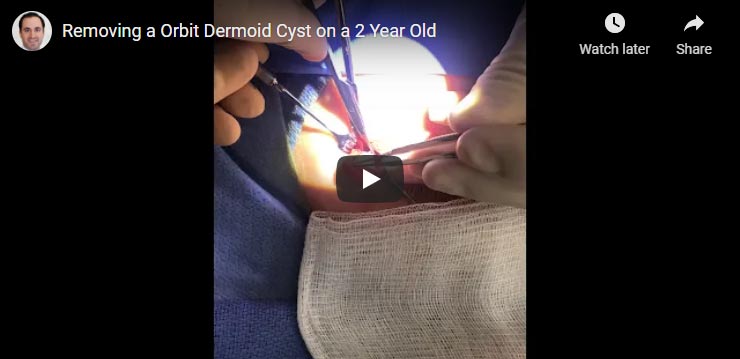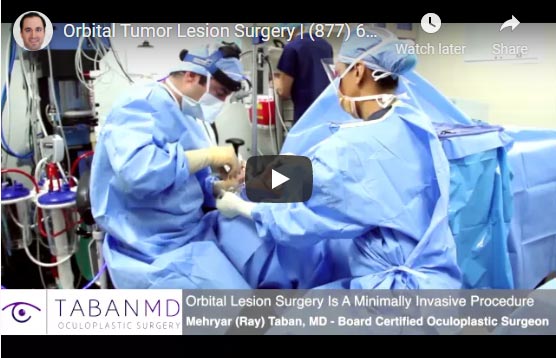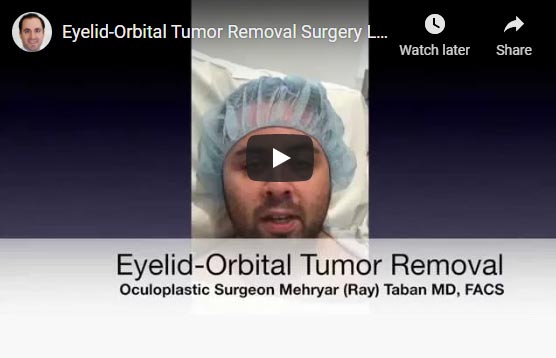Orbital Tumor Surgery, Orbital Infection
Orbital cellulitis is infection of the eye socket. Orbital cellulitis is a dangerous, sight (even life) threatening condition that needs to be managed emergently. The infection usually arises from structures adjacent to the orbits including the eyelids and sinuses. Treatment includes systemic antibiotics and possibly surgery.
Orbital Tumor & Infection Overview
Orbital tumors can be congenital or acquired, benign or malignant, painless or painful. They can happen in both children and adults. They can be subtle and found incidentally (with slow growth) or can behave aggressively (with rapid growth). Symptoms range from none to eye pain/pressure, eye irritation and tearing, swelling, diplopia (double vision), and proptosis (bulgey protruded eyes). Dr. Taban has written a textbook chapter entitled “Orbital tumors: examination techniques” in Clinical Ophthalmic Oncology, detailing the evaluation of orbital tumors.

2 year old boy underwent surgery to remove congenital orbit dermoid cyst.
What Causes Eye Socket Growths?
In both children and adults, a variety of neoplasms (tumors) can occur in the orbit (eye socket). They can arise de novo, from adjacent structures, or secondary to metastasis. Some grow slowly and go unnoticed while others can grow rapidly; impairing vision and causing even greater problems. Symptoms range from none to eye pain/pressure, eye irritation and tearing, swelling, diplopia (double vision), and proptosis (protruded eyes). Dr. Taban has written a textbook chapter entitled “Orbital tumors: examination techniques” in Clinical Ophthalmic Oncology, detailing the evaluation of orbital tumors.
The most common orbital tumors in the pediatric population are dermoid cysts and hemangiomas. The most common orbital tumors in adults are cavernous hemangiomas, metastatic disease, and orbital lymphomas. Other processes can also mimic a tumor such as Graves’ disease, inflammatory conditions, and infections. Dr. Taban has written several articles on eye socket problems, including orbital infections with abscesses.


Read Dr. Taban’s article about Orbital Disease: Propranolol for Orbital Hemangioma
Symptoms
Generally, one of the most common symptoms of eyeball socket tumors and infections is exophthalmos, also known as the protrusion of the eye. Sometimes, tumors will also cause the patient to experience visual problems like partial to whole vision loss, blurry vision, or double vision. Smaller more mild tumors may cause a feeling of pressure near the eye socket, headaches, and moderate vision problems.
Read more about orbital tumors & infections from emedicine.medscape.com.
Detection
In addition to examination by an oculoplastic specialist, imaging of the orbits (either CT or MRI scan) are the best method for detecting and differentiating these tumors. A biopsy of the tumor is often required to diagnose the type of tumor. Treatment options include radiation, chemotherapy and/or surgical removal, depending on the type of the tumor. For instance, the usual treatment for eye socket lymphoma is radiation, while for cavernous hemangioma is surgical removal (when necessary). Dr. Taban has published many articles on using endoscopic technique for orbital tumor removal which may offer a better explanation of the procedure.
Read Article Published by Los Angeles’ Dr. Taban Endoscopic Removal of Nasoglabellar Tumor in a Child
Before & After Photos
CONTACT THE LOS ANGELES OCULOPLASTIC EXPERT
Dr. Taban is one of the leading oculoplastic eye surgery doctors in the LA region. Contact us via online support form, or via telephone at: (310) 278-1836




